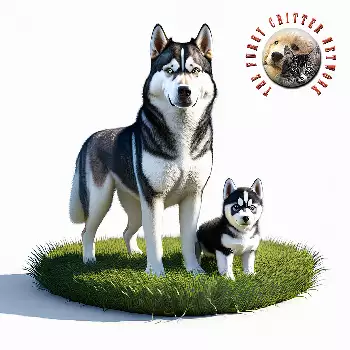The Arctic Husky's ancestry traces back over 3,000 years to the Chukchi people of northeastern Siberia, one of the most isolated human populations on Earth. Living in the harsh Arctic environment of the Chukotka Peninsula, the Chukchi developed a unique culture centered around reindeer herding, sea mammal hunting, and trading across vast frozen distances. They needed a specialized dog capable of pulling light loads at moderate speed across hundreds of miles of frozen terrain in extreme cold, and they spent centuries developing what would become the Siberian Husky.
The Chukchi bred their dogs with remarkable selectivity, creating an animal perfectly adapted to their needs and environment. Unlike many working breeds developed for a single purpose, these dogs needed to balance multiple essential qualities including endurance, speed, temperament, and efficiency. The dogs had to work in teams, so aggressive or quarrelsome individuals were not tolerated. They needed to survive on minimal food while working long hours in brutal conditions, developing the breed's characteristic metabolic efficiency.
Historical accounts indicate that Chukchi dogs lived closely with their people, often sleeping in the family dwelling where they provided warmth and companionship. Women and children cared for the dogs, contributing to the development of the breed's gentle, friendly temperament. Puppies were raised with children, creating dogs that were trustworthy and patient with young family members. This intimate relationship between dog and family, unusual among working breeds, became embedded in the breed's essential character.
The breed remained isolated in Siberia until the early 1900s when fur traders and gold miners began importing them to Alaska. In 1908, a Russian fur trader named William Goosak brought the first team of Siberian dogs to Nome, Alaska, to compete in the All-Alaska Sweepstakes, a 408-mile sled dog race. Local mushers were initially skeptical of these smaller dogs compared to the larger freight dogs common in Alaska, derisively calling them "Siberian rats."
The skepticism vanished when Scottish fox farmer and musher Fox Maule Ramsay imported a team of Siberian dogs in 1909 and placed third in the All-Alaska Sweepstakes. The following year, Ramsay won the race with his Siberian team, establishing the breed's reputation for speed and endurance. Other mushers quickly recognized the superiority of these dogs for racing, and importation from Siberia increased dramatically.
Leonhard Seppala, a Norwegian immigrant working in Nome, became the breed's most famous advocate and the driver most responsible for establishing the Siberian Husky's reputation in North America. Seppala's careful breeding program, based on importing the best working dogs from Siberia, created many of the foundation lines for modern Siberian Huskies. His dogs combined speed, endurance, and trainability to a degree unmatched by other sled dogs of the era.
The breed achieved international fame in 1925 during the serum run to Nome, when relay teams of sled dogs carried diphtheria antitoxin 674 miles from Nenana to Nome in just five and a half days, preventing an epidemic in the isolated town. Seppala and his lead dog Togo covered the most dangerous segment of the journey, traveling 91 miles round-trip in blizzard conditions to meet the relay and then continuing 84 miles to the next relay point. Another musher, Gunnar Kaasen, drove the final leg with lead dog Balto, who became famous despite Togo having performed the more difficult journey.
The serum run captivated the world's attention and brought the Siberian Husky into the public consciousness. Balto was lionized in newspapers and eventually immortalized with a statue in New York's Central Park, while Seppala toured the country with his dogs, demonstrating sled dog racing and promoting the breed. This publicity led to increased interest in the breed not only as working dogs but as companions and show dogs.
The American Kennel Club officially recognized the Siberian Husky in 1930, with the breed standard based on dogs imported and bred by Seppala and other pioneer breeders. The Siberian Husky Club of America was founded in 1938 to preserve the breed's working heritage while accommodating growing interest in showing. Early club members worked to maintain the breed's essential characteristics of temperament, type, and working ability.
During World War II, many Siberian Huskies served in the Army's Arctic Search and Rescue Unit, helping to locate and rescue downed pilots in Greenland, Alaska, and other northern regions. This military service further demonstrated the breed's capabilities and increased public awareness. After the war, returning servicemen brought stories and sometimes dogs home, expanding the breed's presence across North America.
The breed gained additional popularity through literature and film, particularly through books about sled dog racing and Arctic exploration. The 1950s and 1960s saw steady growth in both pet and show populations, though dedicated breeders worked to prevent the temperament problems that can arise from popularity breeding. The breed's striking appearance and friendly nature made it appealing as a companion animal, while its working heritage remained important to many enthusiasts.
Today's Arctic Huskies descend from the working dogs imported from Siberia between 1908 and 1930, when the Soviet government closed the border and ended further importation. Modern breeders work to preserve the breed's original characteristics while adapting to its dual role as working dog and companion. Sled dog racing remains popular, with many Siberian Huskies competing successfully in sprint and middle-distance races. The breed also excels in other activities including skijoring, weight pulling, and agility.
Contemporary Arctic Huskies maintain the physical and mental characteristics that made them successful in their original role, including incredible endurance, efficiency, and the ability to work in extreme cold. The friendly, gentle temperament developed by the Chukchi people remains a defining characteristic, making these dogs unsuitable as guard dogs but excellent as family companions. The breed's history as a working partner to humans in one of Earth's most challenging environments continues to shape its character and appeal in the modern world.

